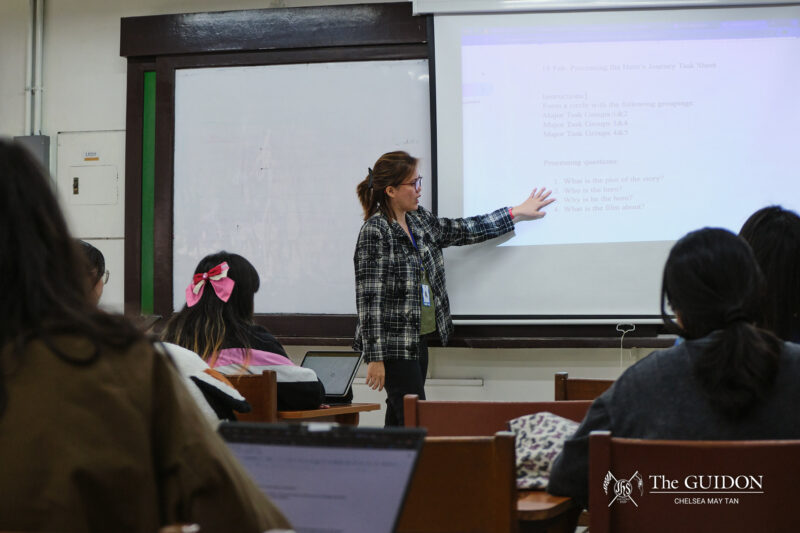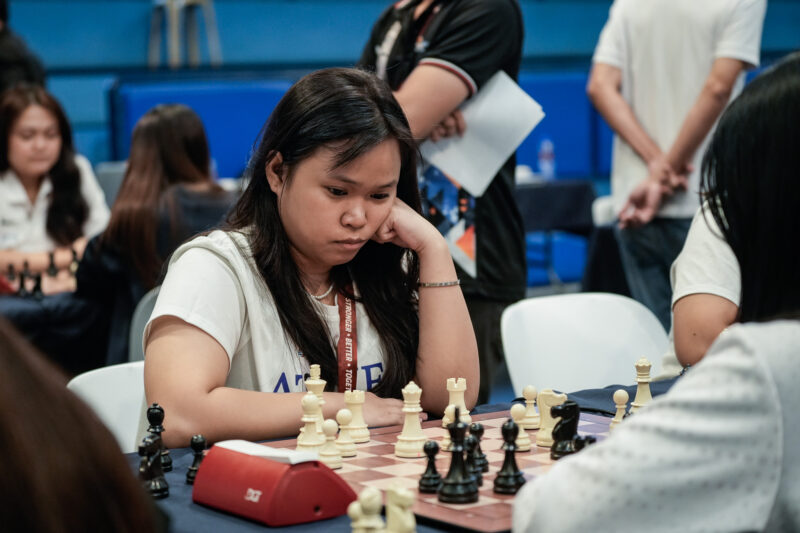While walking near the Shakey’s restaurant in Katipunan, Adrian Lacsamana (AB Pre-Div ’08) and his friends were approached by a boy who looked about seven years old. When the boy asked for money, the students rejected him. With a look of despair on his face, the boy offered to masturbate Lacsamana so he can get paid.
“When I looked at the kid, he [looked] embarrassed to have asked me that,” Lacsamana says in a mix of Filipino and English. “But he said it anyway as if he had no choice.”
While most students consider Katipunan as their hang-out during breaks, street children like this boy consider it as both their playground and workplace. In a presentation prepared by the Barangay Loyola Heights and Learning Links Center for Alternative Education, 26 street children along that area were already identified. These children can usually be found playing with their neighbors, rummaging through garbage, selling bananaque, begging, using rugby, and selling their bodies to appease their hunger.
Begging from the ‘artistas’
According to Childhope Asia Foundation, street children are defined as “young people who spend a considerable time living and/or working on the streets of the world’s cities.” They usually spend from six to 16 hours a day on the streets and typically come from families with six to 10 children.
There are different kinds of street children, says Psychology Department Assistant Professor Liane Alampay, Ph.D. Some of them play on the streets because their houses don’t have much space. Some of them work and play there, despite having their own homes. But, there are others who are more at risk because they either live and work with their families or are abandoned on the streets.
As far as Katipunan is concerned, 76% of the identified street children are aged between 10 to 15 years. 17% are aged between seven to nine years, while 7% are below seven years old.
According to Loyola Heights Barangay Captain Caesar Marquez, these children usually come from nearby communities like Daang Tubo, Marytown, and Ronas. Other part-time street children—those who don’t regularly work on the streets, come from Quezon City’s Libis and Xavierville, and Antipolo City’s Cogeo.
In 13-year-old Lester* and Christian’s* case, they live near the footbridge in front of Mercury Drug. They can usually be found on the streets playing with the other children who hang out there. From 6 am to 6 pm, these boys beg from the “artistas”—a term they use to refer to the students who give them money. By the end of the day, they’ve already went around the Shoppersville-McDonald’s stretch and have earned as much as P130 each.
Christina*, on the other hand, started scavenging for trash with her neighbor cousins when she was seven years old. A year later, she now earns as much as P500 on regular days. Although they have never gotten hurt from their daily operations, Christina and her cousins say that there are some security guards along Katipunan who frighten them off so they won’t enter the establishments.
‘Sheer survival’
Some children earn money so they can get into Katipunan’s internet shops. Says Interactive Children’s Literacy Center (ICLIC) Area Coordinator Alexander Mainit, these children would usually dress up in dirty clothes when they beg in the streets. They then change into cleaner ones and spend P50 of what they earned for an hour or two’s play in these shops.
For most children, however, working on the streets is their families’ source of income. According to Mainit, parents often deny they know that their children work on the streets. But, in one instance, he encountered a parent who’s even proud that his children can already earn money and, thus, buy rice for their family.
“A lot of [the children]’s lives are motivated by sheer survival,” Alampay says. According to her, there are families who find it urgent to have as many members of the household as possible to earn money. She also says that, because of the need to survive, they become greatly exposed to anti-social activities like child trafficking and sexual exploitation. “There is no future in the streets,” she says.
Giving money isn’t an option
For some Ateneans, giving money to the children isn’t an option. “[At times], I walk away without minding them, thinking that it’s just all part of a syndicate anyway,” says Maxine Borja (IV BS LM). “The children are just forced to be in the [streets].”
According to her, she grew up with her parents telling her that these children were forced by their
parents to join syndicates. “I know this isn’t always the case, but to give these kids money is to help the syndicate propagate.”
In Lacsamana’s case, his giving to the street children depends on who they are. According to him, he usually gives anything he has and chats with a physically handicapped girl who hangs out near 7-11 because she’s nice. In other instances, however, he usually ignores the slightly older teenagers who place ice picks beside them while asking passersby for money or leftover food.
Nevertheless, his encounters with the street children changed his perception of Katipunan. Lacsamana says that it’s in Katipunan where one can see the wide gap between the rich and the poor. “It’s ironic that people fill up Katipunan’s food establishments and yet ignore the children who beg outside,” he says in Filipino.
Meanwhile, Musmos President Santi Cang (IV BS Bio) and his co-members find it difficult to explain to the children that they should be at school instead of begging in the streets. Despite this difficulty, Cang says that his being aware of street children’s struggles has helped him become proactive to other equally pressing concerns. “One way that deepened my passion, or even my co-members’, [to continue] what Musmos is doing is… that many Filipinos have so many prejudices about poverty,” he says.
“The only thing that we can do is to try to educate them, [make] them realize that they are equipped with skills… as well as the will to [create] change.”
Change the system
To prevent these children from frequenting the streets, Ateneo alumni founded Learning Links, a non-governmental organization (NGO) that aims to provide supplementary educational materials, in 2000. Five years later, Marquez, together with the Department of Education, acquired and reorganized it into ICLIC because the NGO couldn’t sustain it anymore.
ICLIC usually holds one-hour daily classes at times when children can usually be found on the streets. Its activities include storytelling, movie-watching, and other tasks that aim to develop the children’s learning skills. It also uses the Marungko method, which specifically aims at non-readers to develop their literacy skills.
61 children are currently enrolled under this program, despite the barangay’s forecasted number of 30 to 40 children. ICLIC has proven to be so successful that, according to Marquez, the number of street children lessened from 50 to around 20.
Besides this program, the barangay has also initiated talks with schools like the Ateneo and Miriam College in helping the children. In the Ateneo, these sectors include the Office for Social Concern and Involvement and Musmos.
While there have been joint efforts with barangay officials, some Ateneans have formed their own projects. In Musmos’ case, these projects include tutorial sessions and games for the children every Saturday and leadership training seminars for the teenagers.
According to Ateneo Student Catholic Action (AtSCA) President Kevin Ferraris (IV BS HSc), his organization’s projects include weekly area insertions called “Babad” and regular meetings with the children’s parents called “Bukluran.” It also has joint activities with the Pre-Med Society of the Ateneo such as their medical missions.
For these sectors, however, having few student participants is a constant problem. Says Mainit, the center’s three-man staff and student volunteers are having difficulty in helping the children, the number of whom has increased to about a hundred.
In Musmos’ and AtSCA’s case, their on-campus projects aren’t usually that successful because very few Ateneans are interested to participate. It’s also because of the limited resources and time they have. “[Musmos is] trying to come up with things and projects that at least can spark interest from [the students],” says Cang.
“As of now, we do not have much [activity] that really involve the Ateneo community.”
For Theology Department Lecturer Rachel Sanchez, however, having many volunteers doesn’t necessarily mean a better means of helping the children. According to her, this doesn’t assure the projects’ participants that their impact can change the entire situation. “Poverty is systematic,” she says. “We have to change the system and not just increase its volunteers.”
She also says that, by not striving to help the children, people can more easily fall into materialism, pragmatism, and “many other things that draw us away from our true selves.”
“Service to the children constantly reminds us what [the] the Ateneo education is for,” she says. “It’s not for ourselves. It is for others [as well].”
*Names have been changed to protect the individuals
**With a report from Maan C. Bernardino
A day in the life of a young scavenger
• Nine-year-old Kiko wakes up at 4 am in his house at Daang Tubo near UP. He then walks to his school at Krus na Ligas for his 7 am class.
• Along with neighbors his age, he starts picking up empty bottles and plastic bags after classes have ended. This usually starts at 10 am.
• For kids like Kiko, there’s the risk of being detained by the Department of Social Welfare and Development (DSWD). To avoid getting caught by the barangay officials, Kiko and his friends hide under the parked cars in Katipunan.
• By 5 pm, Kiko’s done with his work. By that time, he and his friends have picked up the trash from the Daang Tubo area to 7-11’s Katipunan branch. They usually earn between P200 and P500 each.
• He goes back to Katipunan in the evening. This time, he scavenges for trash with his family. This is another way for Kiko not to get caught by the barangay officials.
• Kiko and his family stop scavenging by 10 pm. Until his 11 pm bedtime, he studies and does the next day’s homework.







[…] http://theguidon.com/1112/main/2008/12/katipunan’s-young-breadwinners/ […]